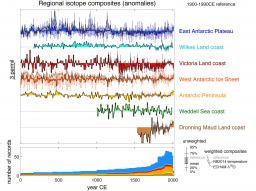
Figure: Regional δ18O composite reconstructions over the last 2000 years using 10-year-binned anomaly data. Both unweighted compos- ites and weighted composites (using both NB2014 temperature and ECHAM δ18O weighting methods) are shown. For each 10-year bin of the unweighted data, the mean δ18O anomaly across all records in the climatic region, as well as the distribution of δ18O anomalies within each bin, is calculated. All anomalies are expressed relative to the 1900–1990 CE interval. The number of records that contribute to the reconstructions for each region are displayed in the lower panel.
Climate trends in the Antarctic region remain poorly characterized, owing to the brevity and scarcity of direct climate observations and the large magnitude of interannual to decadal-scale climate variability. Here, within the framework of the PAGES Antarctica2k working group, we build an enlarged database of ice core water stable isotope records from Antarctica, consisting of 112 records. Our new reconstructions confirm a significant cooling trend from 0 to 1900 CE across all Antarctic regions where records extend back into the 1st millennium, with the exception of the Wilkes Land coast and Weddell Sea coast regions. Within this long-term cooling trend from 0 to 1900 CE, we find that the warmest period occurs between 300 and 1000 CE, and the coldest interval occurs from 1200 to 1900 CE. Since 1900 CE, significant warming trends are identified for the West Antarctic Ice Sheet, the Dronning Maud Land coast and the Antarctic Peninsula regions, and these trends are robust across the distribution of records that contribute to the unweighted isotopic composites and also significant in the weighted temperature reconstructions. Only for the Antarctic Peninsula is this most recent century-scale trend unusual in the context of natural variability over the last 2000 years. However, projected warming of the Antarctic continent during the 21st century may soon see significant and unusual warming develop across other parts of the Antarctic continent
The extended Antarctica2k ice core isotope database developed by this working group opens up many avenues for developing a deeper understanding of the response of Antarctic climate to natural and anthropogenic climate forcings. The first long-term quantification of regional climate in Antarctica presented herein is a basis for data–model comparison and assessments of past, present and future driving factors of Antarctic climate.
Authors : Stenni, B., Curran, M. A. J., Abram, N. J., Orsi, A., Goursaud, S., Masson-Delmotte, V., Neukom, R., Goosse, H., Divine, D., van Ommen, T., Steig, E. J., Dixon, D. A., Thomas, E. R., Bertler, N. A. N., Isaksson, E., Ekaykin, A., Werner, M., and Frezzotti.
Ref. : Clim. Past, 13, 1609-1634, https://doi.org/10.5194/cp-13-1609-2017, 2017
Issu du projet : PAGES-Antarctica 2K






